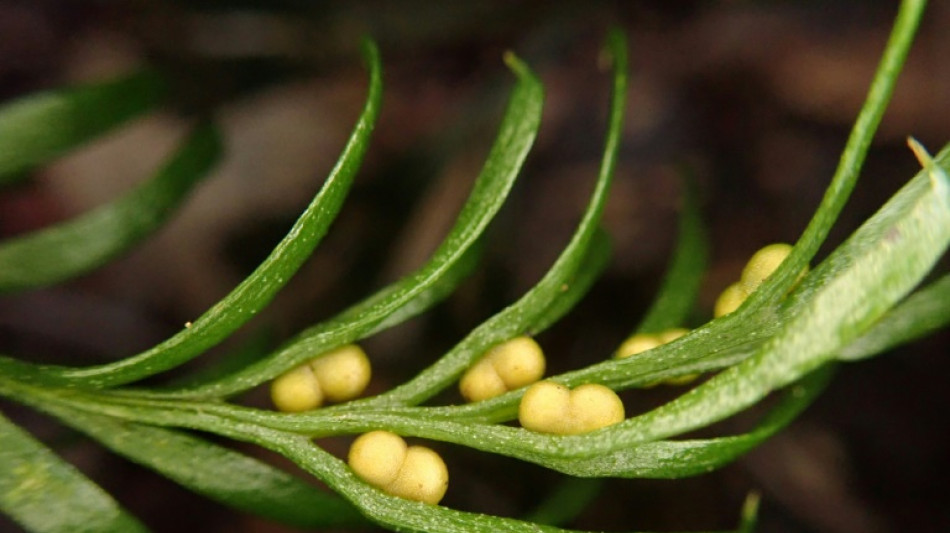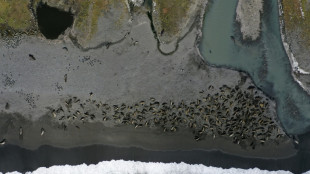
-
 England stars buy into team-first mantra: Tuchel
England stars buy into team-first mantra: Tuchel
-
Fight over fossil fuels drawdown looms at UN climate summit

-
 Blue Origin launches NASA Mars mission and nails booster landing
Blue Origin launches NASA Mars mission and nails booster landing
-
Ronaldo red 'nothing to do with me': Ireland coach

-
 France qualify for World Cup as Portugal, Norway forced to wait
France qualify for World Cup as Portugal, Norway forced to wait
-
US says trade talks with Swiss 'very positive'

-
 Brazil rebuts UN complaint about COP30 security, but boosts presence
Brazil rebuts UN complaint about COP30 security, but boosts presence
-
Swiss Gruyere crowned world cheese champ

-
 Palestinian Authority says Israel killed two teens in West Bank
Palestinian Authority says Israel killed two teens in West Bank
-
Blue Origin launches NASA Mars mission and sticks booster landing

-
 Stocks slide despite end of US government shutdown
Stocks slide despite end of US government shutdown
-
MLS to align calendar with world's top football leagues

-
 BBC says sorry to Trump, but rejects defamation claim
BBC says sorry to Trump, but rejects defamation claim
-
Mbappe, Olise star as France seal spot at 2026 World Cup

-
 Ronaldo sent off as Ireland stun Portugal in World Cup qualifier
Ronaldo sent off as Ireland stun Portugal in World Cup qualifier
-
England cruise against Serbia with Bellingham reduced to cameo role

-
 Osimhen strikes twice as Nigeria set up World Cup clash with DR Congo
Osimhen strikes twice as Nigeria set up World Cup clash with DR Congo
-
Alcaraz beats Sinner to year-end world number one after defeating Musetti at ATP Finals

-
 25 oil-supplying states accused of 'complicity' in Gaza war
25 oil-supplying states accused of 'complicity' in Gaza war
-
Eagles aim to keep rolling despite Brown turmoil

-
 Alcaraz to end year as world number one after seeing off Musetti at ATP Finals
Alcaraz to end year as world number one after seeing off Musetti at ATP Finals
-
Schmidt eager for fan's eye view before last Dublin clash as Wallabies boss

-
 'My whole life is here': migrants in Chile fear far-right rule
'My whole life is here': migrants in Chile fear far-right rule
-
Strong first-half profits keep Alstom firmly on rails

-
 'Like a horror movie': 770 km of fear for those fleeing Sudan's El-Fasher
'Like a horror movie': 770 km of fear for those fleeing Sudan's El-Fasher
-
Pfizer completes Metsera acquisition in deal worth up to $10 bn

-
 Boeing union votes to end strike, accept new contract
Boeing union votes to end strike, accept new contract
-
Farrell says Hansen 'ready and able' to step-in at full-back for Ireland

-
 Osimhen strikes twice as Nigeria keep World Cup hopes alive
Osimhen strikes twice as Nigeria keep World Cup hopes alive
-
Bad Bunny in box seat as Latin Grammys hit Vegas

-
 We need to talk about our fossil fuel addiction: UNEP chief
We need to talk about our fossil fuel addiction: UNEP chief
-
Wales boss Tandy 'excited' to see Rees-Zammit start against Japan

-
 UK artist turns 'money for old rope' into £1m art exhibition
UK artist turns 'money for old rope' into £1m art exhibition
-
Nagelsmann backs Woltemade to shine for injury-hit Germany

-
 Zelensky sanctions associate as fraud scandal rocks Ukraine
Zelensky sanctions associate as fraud scandal rocks Ukraine
-
Starbucks baristas launch strike on chain's 'Red Cup Day'

-
 Fiji unchanged for France Autumn Nations Series trip
Fiji unchanged for France Autumn Nations Series trip
-
All Blacks boss Robertson at ease with 'respectful' England challenge to haka

-
 Stocks on the slide despite end of US shutdown
Stocks on the slide despite end of US shutdown
-
Church bells ring as France marks decade since Paris attacks

-
 France scrum-half Serin commits for two more seasons to Toulon
France scrum-half Serin commits for two more seasons to Toulon
-
Starlink, utilised by Myanmar scam centres, sees usage fall nationwide

-
 YouTube superstar MrBeast opens pop-up park in Saudi Arabia
YouTube superstar MrBeast opens pop-up park in Saudi Arabia
-
'Black Klimt' steps out of shadows and into political tug-of-war

-
 Study flags 'complicity' of oil-supplying states in Gaza war
Study flags 'complicity' of oil-supplying states in Gaza war
-
US shutdown scorecard: Who cashed in, who crashed out

-
 'Bleak' future for seals decimated by bird flu, scientists warn
'Bleak' future for seals decimated by bird flu, scientists warn
-
Australia turn to O'Connor in search of Ireland inspiration

-
 Mexican car industry fears higher tariffs on China will drive its demise
Mexican car industry fears higher tariffs on China will drive its demise
-
Battle brews over Australia or Turkey hosting next COP


'Innocuous-looking' fern wins world record for largest genome
A small, seemingly unremarkable fern that only grows on a remote Pacific island was on Friday crowned the Guinness World Record holder for having the largest genome of any organism on Earth.
The New Caledonian fern, Tmesipteris oblanceolata, has more than 50 times more DNA packed into the nucleus of its cells than humans do.
If the DNA from one of the fern's cells -- which are just a fraction of a millimetre wide -- were unravelled, it would stretch out to 106 metres (350 feet), scientists said in a new study.
Stood upright, the DNA would be taller that than the tower that holds London's famous Big Ben bell.
The fern's genome weighed in at a whopping 160 gigabase pairs (Gbp), the measurement for DNA length.
That is seven percent larger than the previous record holder, the Japanese flowering plant Paris japonica.
The human genome is a relatively puny 3.1 Gbp.
If our DNA were unravelled, it would be around two metres long.
Study co-author Ilia Leitch, a researcher at the UK's Royal Botanic Gardens Kew, told AFP that the team was "really surprised to find something even bigger than Paris japonica".
"We thought we'd already reached the biological limit. We're really pushing at the extremes of biology," she said.
The fern, which grows five to 10 centimetres tall, is only found in New Caledonia, a French Pacific territory which has recently seen unrest.
Two members of the research team travelled to the main island, Grand Terre, in 2023 and worked with local scientists for the study, which was published in the journal iScience.
Guinness World Records awarded the fern its coveted "largest genome title".
The win by "this innocuous-looking" fern demonstrates that "record holders aren't always the showiest on the outside", Guinness World Records managing editor Adam Millward said.
- What's a genome again? -
Humans are estimated to have more than 30 trillion cells in our bodies.
Within each of those cells is a nucleus which contains DNA, which is like a "book of instructions that tells an organism like ourselves how to live and survive", Leitch explained.
All of an organism's DNA is called its genome.
So far, scientists have estimated the genome size of around 20,000 organisms, just a fraction of life on Earth.
Among animals, the marbled lungfish has the largest, with 130 Gbp.
While plants have the biggest genomes, they can also have incredibly small ones. The carnivorous Genlisea aurea's genome is just 0.06 Gbp.
But we humans need not feel inadequate when comparing ourselves to the mighty T. oblanceolata.
All the evidence suggests that having a huge genome is a disadvantage, Leitch said.
The more DNA you have, the larger your cells need to be to squeeze it all in.
For plants, bigger cells mean things like the pores of leaves have to be larger, which can make them grow more slowly.
It is also trickier to make new copies of all that DNA, limiting their reproductive abilities.
This means the most massive genomes are seen in slow-growing, perennial plants which cannot easily adapt to adversity or contend with competition.
Genome size can therefore affect how plants respond to climate change, changing land use and other environmental challenges caused by humans, Leitch said.
- What's all that DNA for? -
There could still be bigger genomes somewhere out there but Leitch thinks this fern must be near the limit.
"I cannot understand how an organism with all this DNA really functions," she said.
Scientists do not know what most of the DNA does in such huge genomes, she admitted.
Some say most of it is "junk DNA".
"But that's probably our own ignorance. Maybe it does have a function, and we have yet to find it," Leitch said.
Jonathan Wendel, a botanist at Iowa State University not involved in the research, agreed it was "astonishing" how much DNA the fern is packing.
But this only "represents the first step", he told AFP.
"A great mystery is the meaning of all of this variation -- how do genomes grow and shrink, and what are the evolutionary causes and consequences of these phenomena?"
Y.Aukaiv--AMWN

